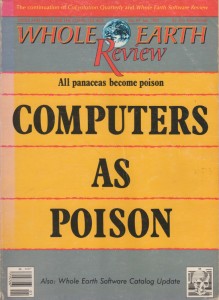June 21, 2016 #related

While wrapping up my review of Ron Kline’s The Cybernetics Moment: Or Why We Call Our Age the Information Age, I fell down the rabbit-hole of his fascinating footnotes and somehow ended up landing on the January 1985 issue of the Whole Earth Review. As Fred Turner has described in From Counterculture to Cyberculture, the Whole Earth Review was designed to “do for computing what the original [Whole Earth Catalog] had done for the counterculture.” Kevin Kelly, one of the editors of Whole Earth Review, famously went on to become the founding editor of Wired Magazine.
I am not sure how representative it is of the whole, but this particular issue is astonishing. The title and theme is “Computers as Poison,” and the contributors include Langdon Winner, E.M. Forster, and R. Crumb! The Winner article is an early version of his now-classic essay “Mythinformation”. The E.M. Forster is his similarly classic 1909 short-story “The Machine Stops”. The R. Crumb cartoons illustrate a remarkably prescient article “Six Grave Doubts about Computers” by the advertising executive-turned-environmental activist Jerry Mander. Of direct relevance to my Dirty Bits project is his questioning of whether or not computers are “clean,” but his discussion of a host of concerns about computing, from its influence on occupational health and safety to its centralizing affects on economic and political power, are part of a larger conversation about the social implications of the computer revolution that has not yet been well-documented by historians of computing.
June 05, 2016 #readings
Here is what I am currently reading. You can find the complete archive here.
One way of thinking about the role of geography in the environmental history of computing is to think about information technology as a form of infrastructure. The key idea here is that infrastructures are critical enabling technologies; their primary purpose is to make other technological and commercial activities possible. As a result, as Susan Leigh Star and Karen Ruhleder have reminded us, infrastructures are intended not to be seen. Technologies become infrastructure only after they are perfected to the point of being routine. We notice them only when they fail.
The global Internet is in that respect the perfect infrastructure: it is omnipresent and invisible; everywhere and nowhere. Using it we can connect to anyone, anywhere, from anywhere, but it does not otherwise intrude on our material reality.
One of the aspects of the Dirty Bits project that has received the most attention is the section that challenges this notion of an “immaterial” infrastructure.
When we look closely at the flows of material that make the virtual possible, we discover that many of most significant social and economic nodes of the Information Society sit at the intersection of traditional, material infrastructures like railroads, power grids, and river systems. The Information Infrastructure of the 21st Century is built around the bones of the 19th century transportation and communication network. These were in turn constructed along river beds and mountain passes. Geography shapes technology, and vice versa.
There is a large and growing literature on infrastructure. Here is what I have been grappling with lately:
Starosielski, N. (2015). The Undersea Network. Duke University Press.
Hecht, J. (2004). City of Light: The Story of Fiber Optics. Oxford University Press.
Jackson, S. J., Edwards, P. N., Bowker, G. C., & Knobel, C. P. (2007). Understanding Infrastructure: History, Heuristics and Cyberinfrastructure Policy. First Monday, 12(6).
Edwards, P. N. (2010). A Vast Machine: Computer Models, Climate Data, and the Politics of Global Warming. MIT Press.
(missing reference)
Jones, C. F. (2014). Routes of Power. Harvard University Press.
Preda, A. (2009). Framing Finance: The Boundaries of Markets and Modern Capitalism. University of Chicago Press.
As you can see from the inclusion of books like the Preda, I am adopting a very broad understanding of what constitutes infrastructure.
March 21, 2016 #readings
Here is what I am currently reading. You can find the complete archive here.
This month I have mostly been reading about Bitcoin and other virtual currencies, as well as some larger economic history for context.
Popper, N. (2015). Digital Gold. HarperCollins.
Castronova, E. (2014). Wildcat Currency. Yale University Press.
Golumbia, D. (2015). Bitcoin as Politics: Distributed Right-Wing Extremism. SSRN Electronic Journal.
Malone, D., & O’Dwyer, K. J. (2014). Bitcoin Mining and Its Energy Footprint. Irish Signals & Systems Conference 2014, 280–285.
March 01, 2016
I have doing a lot of travel giving talks about the Dirty Bits project lately: University of Michigan, Yale, Stanford, University of Nevada Reno. I have gotten some stellar feedback, and look forward to incorporating it. Right now, however, I am just tired.
January 27, 2016 #readings
Here is what I am currently reading. You can find the complete archive here.
I am reading up on the intersection of the history of technology and environmental history. This includes some classics by Tarr & Stine as well as works by up-and-comers like Dolly and Finn Arne Jørgensen.
Stine, J. K., & Tarr, J. A. (1998). At the Intersection of Histories: Technology and the Environment. Technology and Culture, 39(4), 601.
Reuss, M., & Cutcliffe, S. H. (2010). The Illusory Boundary: Environment and Technology in History. University of Virginia Press.
Steinberg, T. (2004). Nature Incorporated : Industrialization and the Waters of New England (Studies in Environment and History). Cambridge University Press.
Pritchard, S. B. (2011). Confluence. Harvard University Press.
Jørgensen, D., Jørgensen, F. A., & Pritchard, S. B. (2013). New Natures: Joining Environmental History with Science and Technology Studies. University of Pittsburgh Pre.
December 16, 2015 #related
The journalist Ingrid Burrington has been doing an excellent series on the infrastructure of the information economy. Her most recent piece, The Environmental Toll of a Netflix Binge references the Dirty Bits project.
Other stellar pieces from this series include: